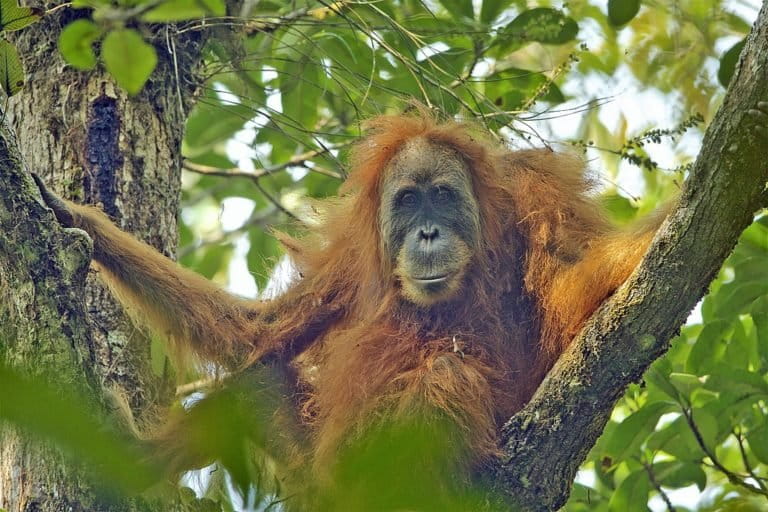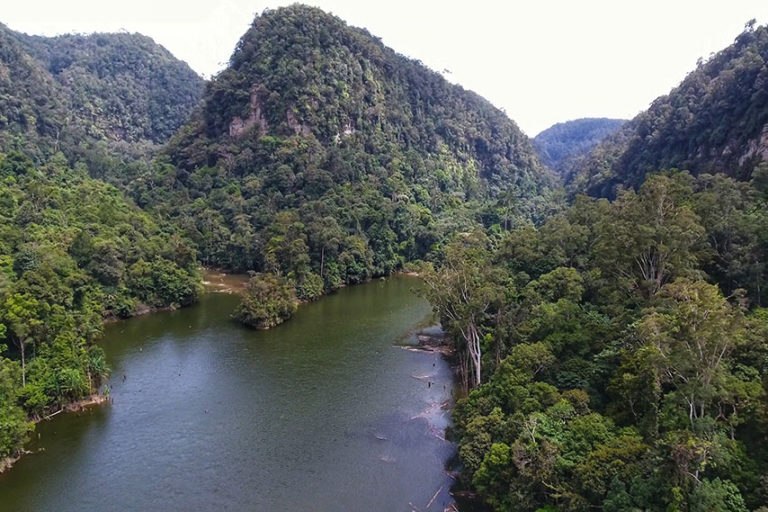- A researcher has claimed that his signature was forged in a document used to obtain a permit for a Chinese-backed $1.6 billion hydropower project in Indonesia.
- If his claim is proven true, the project’s environmental permit would presumably be rendered invalid, raising questions about the project’s future.
- Environmentalists say the cancellation of the project is crucial for the future survival of the Tapanuli orangutan, a newly described great ape that is already at risk of extinction due to habitat fragmentation.
JAKARTA — An Indonesian scientist says his signature was forged to obtain a key permit underlying a $1.6 billion hydropower project in an orangutan habitat on the island of Sumatra.
The revelation casts doubt on the integrity of the licensing process for a project already mired in controversy. The planned power plant is located in the Batang Toru forest in North Sumatra, the only known habitat of the Tapanuli orangutan (Pongo tapanuliensis), a species that was only described last year but is already teetering on the brink of extinction.
One of the prerequisites for construction of the plant to begin was an environmental impact analysis, known locally as an Amdal. But one of the environmental experts whose assessment formed a key part of the Amdal says the document submitted to regulators is different from the one that he worked on — and that his signature on the approved Amdal document was forged.
Onrizal Onrizal, a forestry researcher at North Sumatra University, was asked in 2013 to help draft the Amdal by PT Global Inter Sistem (GIS), a company hired by project developer PT North Sumatra Hydro Energy (NSHE) to conduct the environmental impact assessment.
His task was to assess the biodiversity of the forest. “It was clear that the orangutan wasn’t the only critically endangered species threatened [by the project],” he told Mongabay. “There were also Sumatran tigers there.”
Last September, he was asked why the Amdal document didn’t mention anything about the orangutans or the tigers. He was confused, he said, because the Amdal document that he knew listed both species.
“The new Amdal document doesn’t list either orangutans or tigers,” he said. “There are also other protected species that are omitted [from the new document].”

As Onrizal dug through the new document, which was the version submitted to the authorities and subsequently approved to allow the project to proceed, he realized something else: His name was still listed in the revised Amdal as one of the experts involved in the making of the document, even though he was only helped draft the previous version.
He also saw his signature on the new document, complete with a copy of his diploma and his biography.
“My diploma was also used [in the document] without my permission,” Onrizal said.
He then tried to get confirmation from GIS.
“They admitted they were negligent,” Onrizal said. “They claimed they didn’t do it on purpose. But that’s not possible. How can my signature end up there ‘not on purpose’?’”
Mongabay contacted GIS for confirmation, but the company didn’t respond as of the time this article was published. NSHE said the case was a matter for GIS as its outside consultant.
“Any dispute related to the name and the signature in the Amdal document is an internal matter of the consultancy company,” Firman Taufick, an NSHE spokesman, told Mongabay.

‘Smoking gun’
The project is the subject of an ongoing lawsuit filed by the Indonesian Forum for the Environment (Walhi), the country’s biggest green NGO. The lawsuit seeks to revoke the environmental permit for NSHE, issued by the North Sumatra provincial government based on the Amdal.
The lawsuit’s underlying arguments are that the project carries a high environmental risk, and that NHSE made a series of administrative errors when acquiring the permit, such as overlooking the risk of earthquakes in the area.
The new claim that Onrizal’s findings were omitted and his signature forged could be key to determining whether the project is stopped, or at least suspended, according to William F. Laurance, a professor at James Cook University in Australia who led a major study of the Tapanuli orangutan. Laurance is also the director of the Alliance of Leading Environmental Researchers & Thinkers (ALERT), which last year called on the Indonesian government to stop the project. (Editor’s note: Laurance is a member of Mongabay’s advisory board.)
“To me this looks close to a smoking gun, and Onrizal is a very solid guy,” Laurance told Mongabay.
If Onrizal didn’t sign off on the final Amdal, that would render the document invalid. And since that document was used by the provincial government as the basis to grant the environmental permit, then the permit itself would also be invalid, according to Golfrid Siregar, the counsel for Walhi’s North Sumatra chapter.
“The forgery should be a very strong [piece of] evidence for the judges to decide [the case on],” he said.
If the permit is found to be invalid, he said, the project should be stopped. Any activity undertaken on the project before the issuance of another environmental permit would be illegal, Golfrid said.
“If we’re talking about the law, if the procedure [to obtain the environmental permit] is flawed, then the permit should be revoked,” he said. “Even if the company still has other permits, if there’s no environmental permit, then no operation is allowed, based on the law. If the project still continues without an environmental permit, it’s clearly a crime.”

Golfrid said GIS should also be held accountable as the party that drew up the Amdal document.
“They forged [the signature] and that’s a crime,” he said. “An Amdal document is a public document. It means they’ve forged a public document.”
Onrizal and Walhi have filed reports with the North Sumatra police three times over the allegation of the signature forgery, but the police have dismissed the claims each time.
The first time they were rejected, they said, it was because the police needed a letter of authority to process the report. The second time, the police said Onrizal needed to file the report in person, as the aggrieved party in the complaint. He was in Penang, Malaysia, at that time.
The third time, Onrizal duly filed the report in person, but the police said they needed the actual Amdal document and not a copy of it, as well as evidence that the forged signature had been used to obtain the environmental permit.
“That’s not possible because it wasn’t me who made the new Amdal document,” Onrizal said. “It’s the police’s job to search for evidence. Instead, we’re told to look for the evidence and the original document ourselves.”
Golfrid said Walhi had asked for the Amdal document from the North Sumatra environmental agency, but the agency only held a copy. The original document is in GIS’s possession, and thus will be difficult to obtain, he said.
Golfrid said Walhi might report the case to the national police if the provincial police keep rejecting them.
In the meantime, Onrizal has testified in the lawsuit, telling the court that he wasn’t involved in the revision of the Amdal and thus had no idea how his signature end up in the final document.
Golfrid said Walhi planned to submit this testimony to police as evidence. Ronald M. Siahaan, Walhi’s chief legal counsel, said Onrizal’s testimony itself was the strongest evidence that could tip the scales in their favor. The court is scheduled to rule on the lawsuit on March 4.
“All of our arguments are backed by strong evidence, which the defendant couldn’t rebuke during the court proceedings,” he told Mongabay. “We could prove that while the Amdal process might be correct administratively, the content of the document is filled with lies and deceit.”
Besides the alleged forgery of Onrizal’s signature, environmentalists have also questioned the Amdal document’s omission of eight endangered species from the list of wildlife found in the Batang Toru forest.
The previous version listed 23 species, while the final one has 15. Those missing include the Tapanuli orangutan, Sumatran tiger, sun bear, and Sumatran lar gibbon.
“The new Amdal document is a revision of the old one, so it’s supposed to be thicker than the old document. But this one is thinner,” Golfrid said. “The aspects that were supposed to be revised were only a change in the location of the quarry as well as the increase in the plant’s capacity from 500 megawatts to 510 megawatts. So why was the list of threatened species changed?”


The hydropower plant was announced in 2012 and would be the largest on Sumatra if completed as planned by 2022. The Indonesian government considers it a priority project under President Joko Widodo’s wider infrastructure-building push.
Environmentalists, including 25 members of ALERT, have pleaded to the government to stop the project. They say they fear the dam would damage the most critical areas of the habitat of the Tapanuli orangutan, the rarest great ape species in the world.
Over the course of three generations, the population of Tapanuli orangutans has plummeted by 83 percent, leaving fewer than 800 individuals surviving in a tiny tract of forest less than one-fifth the size of the metropolitan area that comprises Indonesia’s capital, Jakarta.
Even before the hydropower dam goes into operation, the apes have already started fleeing from their habitat and encroaching on nearby plantations, reportedly due to the presence of heavy equipment in the area.
Banner image: Frontal view of a Tapanuli orangutan in Batang Toru forest complex, North Sumatra, Indonesia. Image by Tim Laman/Wikimedia Commons.
